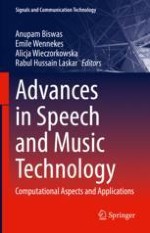This book presents advances in speech and music in the domain of audio signal processing. The book begins with introductory chapters on the basics of speech and music, and then proceeds to computational aspects of speech and music, including music information retrieval and spoken language processing. The authors discuss the intersection in the field of computer science, musicology and speech analysis, and how the multifaceted nature of speech and music information processing requires unique algorithms, systems using sophisticated signal processing, and machine learning techniques that better extract useful information. The authors discuss how a deep understanding of both speech and music in terms of perception, emotion, mood, gesture and cognition is essential for successful application. Also discussed is the overwhelming amount of data that has been generated across the world that requires efficient processing for better maintenance, retrieval, indexing and querying and how machine learning and artificial intelligence are most suited for these computational tasks. The book provides both technological knowledge and a comprehensive treatment of essential topics in speech and music processing.
